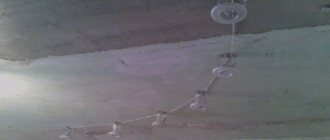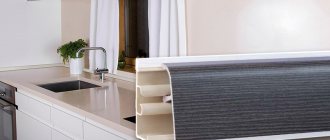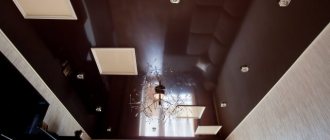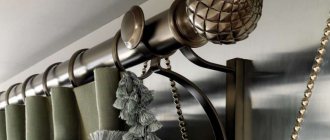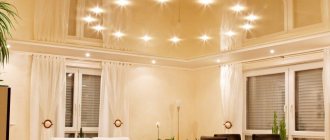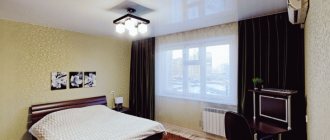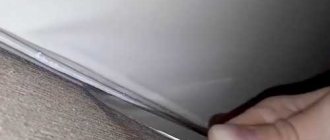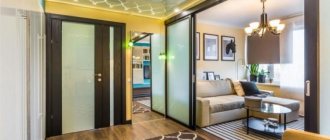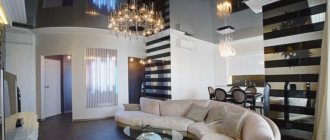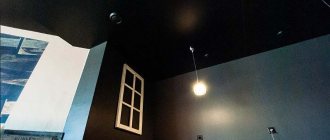Installation of suspended ceilings is a labor-intensive process that scares off many beginners. Indeed, to solve the assigned problems, you will have to prepare a sufficient set of tools, study the technical part, purchase equipment and materials.
At the same time, some points should be thought out even before attaching the stretch ceiling.
One of these issues is the installation of a ceiling cornice. What types of cornices are there?
Which installation options should you prefer? How much will the work cost? Each issue requires detailed consideration, which is what we will do.
How to make a curtain on a suspended ceiling?
The main advantage of ceiling cornices is ease of installation. Most often, the product is fixed to a regular (base) ceiling, which is a concrete slab.
In such cases, there are no problems with fastening and all work (even for an amateur) takes no more than 15-20 minutes.
The situation is different when it comes to plasterboard structures.
It is worth considering here that plasterboard structures cannot support large masses. That is why it is recommended to give preference to light curtain rods and curtains.
If the task is to hang products made of heavy fabric, then the fastening should be carried out not to the ceiling, but to the wall.
The task is more difficult if you need to attach a ceiling curtain under a suspended ceiling. Here you will have to think about it, because it is impossible to attach the baguette directly to the PVC film - it will be deformed, and the ceiling will lose its appearance.
Here you will have to look for other options, which are given below.
How to make a curtain for a suspended ceiling? There are three mounting methods:
1.The first option is to fix the cornice on a tension structure.
In this case, the installation is carried out using a support mortgage. A wooden beam is attached to the main ceiling, after which a PVC film is attached.
In this case, the block is located behind the suspended ceiling (closer to the window). Next, the tension structure is fixed to the beam. The advantage is that it covers the entire ceiling area.
2. The second option is to install the cornice in a special niche (mounted near the window).
It is into this structure that the cornice is attached. Here a block is drilled to the base ceiling, located 25-30 cm from the window.
A wall profile is attached to the bottom of the beam, where the PVC film is placed. With this design, the suspended ceiling does not reach the window, forming a niche.
The resulting space is enough to install a cornice to the main ceiling. This option is considered "hidden". The advantage is a unique visual effect, due to which the curtains appear to be lowered from the tension structure.
The video shows the design feature of a hidden curtain under a suspended ceiling
3. The third option is similar to the second with the only difference being that the thrust beam is hidden behind a PVC film. This type of execution is considered the most aesthetic.
To accomplish the task, a beam is attached at a distance of 20-25 cm from the window, after which hidden profiles are fixed to the latter, where the film is inserted.
Thanks to the use of two types of profiles (ceiling and bending), bending of the canvas and hiding of the beam behind the plane of the ceiling structure is guaranteed. Next, the cornice is attached to the main ceiling of the room.
The last method is considered the most expensive, but this is easily explained - it is the most aesthetically pleasing, difficult to implement, and the space behind the beam is reliably protected from dirt and dust.
In addition, the resulting niche can be used to install spotlights or LED lighting.
Below we will consider in more detail the open and hidden method of installing a cornice.
Features of ceiling consoles
Cornices for suspended ceilings are a flat element designed for fastening textiles and performing 2 functions:
- decorative;
- practical.
Consoles are made from wood, plastic, aluminum or steel. The cheapest are plastic, and the most expensive are made of natural wood. Steel curtain rods are used when heavy fabric is to be hung. Aluminum products are an average option in terms of price and functionality.
The advantages of ceiling consoles are:
- Possibility to hide fasteners.
- Design or delimit the ceiling area in an original way.
- Visually increase the space.
- Possibility of remote control of the console (in case of very high ceilings).
How to hang a curtain on a suspended ceiling: the open method
As discussed above, the open method of installing cornices is the easiest to implement and affordable.
Here the installation is performed according to the following algorithm:
- The location for attaching the ceiling cornice is determined, followed by marking points for installation. This work must be done in advance - before the start of the main work;
- marking the perimeter of the room with fixing a special profile for the ceiling to the walls;
- fastening along the previously marked line of the wooden block. The latter is fixed with dowels. The latter should be driven into holes previously made in the ceiling. Pay special attention to the choice of timber - its lower part should be closely adjacent to the PVC film. To adjust this parameter, it may be necessary to install special wedges between the ceiling and the beam;
- after fixing the beam, the ceiling sheet is stretched;
- The cornice is attached using self-tapping screws. You should act carefully to prevent damage to the PVC film. In places where the self-tapping screw passes through the tension structure, polymer rings are installed. In this case, the holes should not be cut, but burned;
- When installed correctly, the beam for attaching the cornice is hidden behind the structure.
The advantages of this option are ease of execution, high installation speed, and minimal costs.
An important point in the process of performing work is installing curtains under a suspended ceiling. Here it is important to strictly follow the sequence of actions and a number of rules.
Pros and cons of masking curtains
A niche formed in a suspended ceiling has the following advantages:
- Mechanism and fastening parts are securely hidden inside the structure; Only the surface of the canvas and textiles appear to the eye - everything looks elegant and harmonious.
- Using a niche eliminates the need to choose cornices and fixtures that match the style of the interior. You save time and money.
- If the canvas is glossy, an interesting effect is obtained. Curtains are reflected in the ceiling and look longer; this makes the room visually higher, which is always nice.
Bedroom with a disguised cornice Source wp.com
- A niche is a structural element that can be used in any style; the final result depends only on the choice of textiles.
- A niche is a suitable place to install decorative lighting. Hidden lighting looks charming and is completely safe: LEDs are used, which do not heat up, and therefore can be placed close to textiles.
The disadvantage of the design is the need to foresee it in advance and include it in the design project before installation work begins. Once the canvas is stretched over the profile, no additions can be made. Installing a ceiling cornice without a niche is risky, as there is a possibility of damage to the decorative coating.
With soft LED backlight Source nevapotolok.ru
Niche for a curtain in a suspended ceiling: subtleties of hidden design
People who put aesthetics first prefer installing a cornice in a hidden niche. But how to hide a curtain under a suspended ceiling so that it looks most aesthetically pleasing?
Here the algorithm of actions looks like this:
- purchase of a cornice (before measuring the ceiling). This is due to the fact that the size of the future niche and, accordingly, the size of the PVC ceiling structure depend on the size of the device;
- The cornice is attached to the base ceiling. Dowels are used for fixation. The sleeve can be made of different materials (metal, plastic);
- At a distance of several millimeters from the cornice, a block is fixed to which a special profile for PVC film is installed. The profile is fastened from the side of the cornice, which makes the beam virtually invisible;
- The product looks most impressive when combined with glossy PVC film.
There is an opinion on the Internet that only professionals with extensive experience and special equipment can handle the installation of a stretch ceiling. But that's not true. If you have certain knowledge and tools, you can do the job yourself.
Precautions when performing work
Whatever method we use, installation before or after stretching the ceiling, we must take into account all sorts of minor troubles that may occur during the work. So, any cornice, be it made of plastic or an aluminum profile, will always have a sharp edge or some kind of unevenness or jagged surface. These little things are not important for the curtain holder itself, but you can accidentally catch the delicate film of the ceiling and hopelessly ruin it. Therefore, it is better to wrap the edges of the tire with cloth.
We remember that any hole in the film must be reinforced with plastic thermal rings so that a gap does not subsequently form in its place. It is advisable that the installation of the cornice be carried out by the same company that installs your ceiling.
What is it for? It's all about the warranty on the film. The company guarantees the installation of such canvas as specified in the contract. The warranty covers the tearing of the fabric along the seam and the detachment of the mounting profile from the wall. These factors indicate poor quality of the film and welding of the material. All other defects do not count.
If you install the cornice yourself and the ceiling is damaged as a result of the installation, then only you will be to blame. It’s another matter if the film was damaged by the installers themselves, then all costs fall on the contractor. However, not everything may be smooth here either. Let’s say you didn’t foresee such consequences and didn’t put plugs on the edges of the tire, the performers may blame you for this. You, in turn, can point out to them that they, as experienced specialists, could suggest such a development of events.
In any case, it is better for everything to go “without a hitch” - forewarned is forearmed.
Ceiling curtain suspended ceiling: choosing a cornice
To understand the compatibility of cornices and suspended ceilings, it is worth knowing as much as possible about the types and features of products that exist on the market. All cornices are conventionally divided into ceiling and wall.
Based on material, cornices are classified as follows:
- plastic. Such products are in greatest demand due to their affordable price and low weight. In addition, plastic products are durable and flexible. Curtains move along the grooves with maximum smoothness, without delays;
- wooden. Despite the external richness and even luxury of such products, they look very bulky. Wooden cornices are more suitable for rooms that have suspended ceilings. Disadvantages - high price and weight, which was mentioned above. If suspended ceilings and curtains with heavy material are planned, then this option is hardly optimal;
- steel. Such products are durable and reliable, so they are mounted just for the installation of heavy curtains and curtains. Installation of products is carried out using wooden or plastic pads;
- aluminum. The advantage is light weight and strength. In addition, during the installation process various decorative products are used that can decorate the appearance.
All types of cornices considered are presented in different colors, which allows you to choose the best option.
All cornices are divided into three types:
- baguette cornices are products that are made using various materials (most often wood). They can be wall or ceiling;
- round cornices. This design looks like a rod with rings moving along it. The material for the production of products is plastic, wood or metal. The inside of the cornice is hollow or filled (the first option is easier). The tip has a decorative function and is made in a curly or round shape. The round cornice is mounted only to the wall surface;
- profile cornices. Devices of this type are suitable for various types of curtains. Fixation can be carried out to the wall or ceiling. The materials used are plastic and aluminum. The product consists of several grouped tires. There is also a type of curtain rods designed for curtains with lambrequins.
When choosing curtains, you should consider a few tips:
- Curtains are purchased with a length reserve. It is desirable that the distance from the edge of the curtain to the window be 30 centimeters or more. In this case, there will be no problems with opening the curtains;
- It is worth leaving a certain distance from the radiator, window and window sill to the curtain. This is necessary so that the curtains do not touch the radiator and the window sill. Often 20-25 centimeters is enough. It is at this distance that the ceiling curtain is installed.
Cornice design
When thinking about the future design of the window area of the room, you must immediately decide on the design of the cornice. There are several main options:
- string cornice It is a stretched wire with hooks to which the curtain is attached. Most models are equipped with a string tension regulator. An excellent minimalist option, but such a curtain rod is unlikely to withstand heavy curtains;
- tire cornice It looks like a flat plate with several slots for mounting hooks. Several layers of curtains can be attached to one such curtain rod;
- profile cornice made of aluminum. Thanks to its high flexibility, it can be bent almost any way, which allows you to use profile cornices to design semicircular window openings;
- Separately, it is worth highlighting the flexible cornice , which is made of plastic. It can be given absolutely any shape, creating an unusual trajectory for the curtains. Such cornices are often used not even when decorating a window opening, but for zoning space and creating a screen;
- baguette cornice It is distinguished by the presence of a decorative strip around the curtain fastening system, i.e. the hooks will not be visible at all. Sometimes LED lighting is mounted under the bar, obtaining an original result. A good option for open ceiling or wall mounting.
Cornices also differ in the number of guides. The most popular models are those with two guides: you can hang tulle and curtains on such a cornice. If it is necessary to decorate the structure with a lambrequin, choose a cornice with three guides. If blinds are chosen to darken the room, and only translucent tulle will be attached to the cornice, then you can take the simplest and cheapest option with one guide.
There is a classification according to the control method:
- mechanical curtain rods are a true classic. To open and close the curtains, you need to pull the cord. Everything is simple and reliable;
- A motorized curtain rod allows you to open and close curtains simply by pressing a button. The decision is justified if the curtains are long, wide, heavy, and you regularly manipulate them.
Separately, it is worth highlighting the so-called. “smart” curtain rods , which, thanks to a controller and a sensor system, can open and close themselves according to a certain schedule or depending on the light level in the room. In some cases, you can enable the effect of presence when no one is at home.
Curtains for a suspended ceiling: how much will it cost?
Before you buy a curtain for a suspended ceiling, and decide on the type of cornice.
At the same time, it is worth considering the total costs of purchasing the product and its installation.
Thus, installing an open curtain under a tension structure (if ordered from specialized companies) will cost 500-700 rubles per linear meter.
It is worth knowing the cost of curtains, which varies depending on the type.
Here the prices look like this:
- A 3-row curtain 1.6-4.0 meters long costs from 600 to 1450 rubles;
- 2-row curtain 1.6-4.0 meters long - from 400 to 1100 rubles.
In addition, certain costs occur when purchasing accessories:
- decorative strip costs 100 rubles per linear meter;
- roundings for 3 and 2 row curtains - 300-350 rubles.
As for the installation of hidden curtains, the cost here is higher - 700-900 rubles per linear meter. Here, a ceiling type of structure can be used as a cornice.
If the installation is carried out personally, then first of all you should focus not on the costs (they are approximately identical), but on the availability of certain skills and the planned design.
To figure out how to attach a curtain to a suspended ceiling, it is worth knowing the options and advantages of each type of fastening.
Installation features
On the wall
The only difficulty is accurate marking. It is necessary to take measurements between the individual mounting pads. After this, marks are made for drilling.
To ensure a safe installation, you should adhere to the following rules:
- Do not use black self-tapping screws during installation. The radial load will break them in half and cause the curtain rod system to fall.
- It is better to use a hammer or laser level. This way you won’t be able to allow any misalignment. It is better to navigate by the slope of the ceiling.
- Short curtains for the kitchen: examples of the most exclusive options and new products for short curtains up to the window sill
Fashionable curtains for the bedroom: real photos of new curtain designs in the bedroom
- Secrets and rules for choosing curtains for the living room
To the ceiling
Ceiling cornice for suspended ceilings may seem complicated at first glance. In fact, its installation is not standard and requires more care. But even a person without experience in installing ceiling models can cope with this. Moreover, everyone already has all the tools in their pantry.
It seems that the bar is installed on the canvas itself. In fact, the installation is carried out on a special wooden block, which is located under it. In some cases, it can be replaced with a special metal or plastic strip with perforations. This method is more durable, since the crossbar, unlike wood, will not rot and will not move away from the wall. But the regulation and installation method is more complicated. In the case of timber, it is important that it is solid, without jumpers.
The block is often installed using an adjustable aluminum hanger (like when installing drywall). Mounting to the side corners is also suitable. This is more convenient than attaching it directly to the ceiling. It is important to achieve some freedom when adjusting, since otherwise the cornice may become skewed.
Metal and plastic strips do not need such careful selection. They only have strength classes.
Photo of curtains under a suspended ceiling - help in choosing
Before starting installation, you should study the prices and photos of curtains for suspended ceilings. The costs of performing the work are discussed in the section above.
As for photographs, it is worth paying attention to:
- types of cornices and features of their fastening;
- step-by-step execution of work when installing curtains in open and closed ways;
- options for LED lighting in the formed niche (if such is planned);
- photographs of curtains for curtains under a suspended ceiling;
- execution options.
The more information in front of your eyes in the form of photographs, the more accurately the work will be done, and the better the final result. In this case, there are always two options:
- do the work yourself. The advantage is saving money. Disadvantage – high risk of damaging expensive PVC film;
- entrust the installation to specialists. In this case, you can count on results. Disadvantages are higher costs that you have to put up with, as well as a high risk of running into unprofessionals.
������������ �� ����� ���� ������� �������, ��� �������� �����������? ����������� � ���������� �������! ������ ��� �� ������, ����� ������ ���������, ���� ���� � �������, � ������ ������������. ���������� ������� ������� �������� ��� �������� �������. ������� ���, ��� ������, ��� ������� �� �������� ��� ����� �������, ��������. ��� � ��� ��������, ���� ��������� � ������� �� ������� ���� � ���� � ����� ��������� ������������.��� �������� ���������� �������, ��� � ������� ��������� ������ ������������. ��� ���������� ��, ���� � ������ ��� �� ������������� ����� �����, � ��������� ���� �����? ������� ������ ������� ��������.������ ��� ��������� ������� �������� �����. ����� ����� �� ��������������, �������� ��� �������, ��� ����������� � ��� ������ �������� �������.��������� ����� � ������ ������������ ��������.
����� ������������� �������, ����������� ���������, ������� �� � ��������� � �������� ������ � ��������. � ��������� ����� ������ ��� ����������� ������������ ��������� �����. �������� � ��������, ������ �� ��� � ������������ ��� �������� �������������� ��������.
���������� ��� ������ ������� ������� �� �������, ����� ��� ������ �������� ��������.� ���� ������, �� ������������ ����� ������������� ������ � ��� �����, ��� � ������� ����� ������ �������������, ����������� ��������. � �������� ��������� �������� ���� ������, ���������� ������ ��� ����������. �������� � ������ ������ �������� ���������. ������ �������� �������� ��������� �������� �������. ����� � ��� ������, ��� ������������� ������, ������������ ������, ������� ������ ���� ��������� �������.
�������� ������� ������, ���� �������� ������� � ������ ������������� ���� � ������. ����������, ��� �������� ��������� ���������� ����� ���� � �����:
- ������������� � ������� �� �������� �������, ��� �� ������� ������� ��������� � ��������� �������� �����������. ����� ���������� ������� ������ ������� ������� ��� ������ ���������. ����� �����, ��� ����������� ���������� �������� �� ������. ������, �� ������ ����� ��������, � � ���� �������� � ������ ����� ���� �� ������ �� ���� ������ � ����� ��������. ������, ��� ���������, ���� ����������. �������, ��������� ����������� � ���������� ������ ����� ������� �������, ����� �������� ��� ������ ��������� � ���� ������������� ��� ��� � ������� ����� ���������.
������ �������!�������� ��� �������� ���������� �� ������ ������� ������������� � ������ � �������. � ���� ������ ���.
���������� �� ������� �����, ���� ������ �� ���� ��������, ��� ���������� ����� ���������, � ��������� �������� ����������� ���������� � ���� ���� � ����. ������ ������� � ���������. ��� ������������� ������ ��������� ������� ���������� ��������� ������� � ���������.
- ����, ������ ������ � ������������ ��������� �����. ������ �������� ������� �������� �� ����� �������. �������� ����� ��������������� ����� � �����, �� ������� � ����� ��������������� ��� �������� ������. ������� ��������� � �������� ��������. ������ ������������ ��������� ����� �� �������. ��������� �������, ��� ��������� � ������, ������, ��� ���� �� ����� ���������� ������ ������ �� ����, � ��������������� �� ����������� ��� �������. ��������� ����� �� ��������� ����������� ������. ��� ���������, ����� ����������� �����������, � �� ����������.
- ������ ���������� � ���������� � ��������� ���������. �������� ���������� ������, ���� �� ����� �������������� �������. �������� ������ ������ �� ������ �������� ��������� �������. �������������� ��� ������� ��������� ����� �������� � ��������.
- ��� ��������, ��� ��������� �������� �������� ������ ��� ������, ����� ������� ��� �������� ��������� �������. ������, ��� ����������� ���������, ������������� ������� ������ ������������. ���� ������������ � �������� �� ��� ������� �� ������ ��� ������.
- ������ ������ ����� ����������� �� �������, ���� �� ������ ���� ���������. ������� ����������� ���� � ���� ��������� ���������. ������ ����� ����������� � ��������� ��������� �������. � ���� ��������� ������� ���������� � ������ �������� ������ �����.
- �������, �������� ������� �����. �������� ������ ������������ � ��������. ���������� ����� ��������� ��� �� ����������� �������, ��� � �� ����� �������. �������� ����� ��������. �������, ���� �������� ������� � ������ ������������ ���������.
- �� � ��������� �����������, ������ ���������� ������� �� ������ ��� ������, ��� ����� ��� ����������. ��������� ������ �� ��������.
�����!����, �������� ��� ����� ������, ����� ����������, ��� �������, ���� �������� ������� �� ��� ������. ��� ����� ��������. � ������, ��� �������� ��������� ��������� ��������, ��������� ����� ���������� ��� ������� ������ ����������.
������ �������, ��� ����� ���������� ����������� ���������� �� ������, ��� ����� ������, ���� ����������������� ������������� �� ������.������ �������� ������� ������������� �� �� ��� ����������� �������, � ����������� ��������� �������� �����, ���� � �������� ������. � ����� �������� �������� ������� ������. � ���������� ������� ���������� �������, ��� ����� ��������� ������ ������� � �������, �� ��������� ���������� ��������. �� � ���, ��� �� ������������ � ����� ������ ������, �� ��� ����� �� ����� ����� ����� ����� ������.��� ������ ���� �������� ����� ������. ������������, ���� �� ������ �������� ��������� �������, �� ����� �������� ������������ �������.��� ������, ������ �� ������ �������. ����� ����� ����������� � ����������, ������ � �������, � �������. �������������� ��� ����������� ������� ������, ��� �����, ���� �� ������� � ���� ����. �� �������� ������������� ��������, ���������� ������������� � ��� ����� ������������!
Having started a renovation with a conventional suspended ceiling, the curtain is usually selected at the final stage, when all the rough work has been done and the wallpaper has already been pasted. If the renovation of the room is planned with the installation of a stretch ceiling, then the timing of the actions is somewhat different, and you should take care of what type of curtain the curtain will be in advance. What types of curtains for suspended ceilings exist, and how to install them?
Basic installation methods
So, ceiling installation is more reliable than wall installation. But what types of installation are there and which one is better to choose?
Open
The method has existed since the very appearance of suspended ceilings on the Russian market. During finishing work, craftsmen attach a beam of a suitable size (or adjustable brackets with plywood) to a concrete base, then stretch the canvas and screw a cornice (usually plastic) through it to the beam. Essentially the method is the same as attaching lamps or chandeliers.
The open method does not have many advantages, the main one being low cost. The average cost of installing a mortgage is 1000 rubles.
However, damage to the canvas and the appearance of a cheap plastic tire overshadow the joy of the finished result. But the craftsmen managed to find a modern alternative to the open installation method.
The photo shows an open ceiling cornice
Hidden
Hidden curtain rods for suspended ceilings are actively gaining popularity primarily due to the aesthetic component. If you arrange a niche between the wall with the window opening and the ceiling panel, you can achieve the effect that the curtains are floating in the air. Invisibility of fastenings, the ability to install beautiful lighting, reliability (the curtain is installed directly to the concrete floor) - this is not the whole list of advantages of a hidden cornice.
A standard niche takes the entire wall and has the shape of an elongated rectangle. Its edge farthest from the window should extend beyond the parallel with the radiator by 7-10 cm - this is enough for the curtains to hang evenly and beautifully and move easily.
Advice! To calculate the width of the niche, measure the distance from the wall to the far edge of the battery and add 7-10 cm.
A niche can be organized both in a standard square or rectangular room, and in a room with complex architecture - a sloping wall, a bay window.
Combined
This solution for a stretch ceiling can be called “semi-hidden”. During finishing, craftsmen create a complex structure from brackets and profiles, which allows you to literally mount the tire into the same plane as the ceiling. Thanks to the use of materials of the same shade (usually white), the curtain guide remains invisible.
The advantage of this method is that the entire perimeter of the ceiling is hidden by a PVC sheet, and the cornice is completely invisible to you and your guests.
Advice! To achieve the effect of a flowing curtain from the ceiling (as in the hidden version), ask the master to make the profile located closer to the wall a little higher - the height difference will create the necessary impression (look at the photo).
The photo shows a combined tire mount in a nursery
Methods of attaching curtains to a suspended ceiling
Having decided to install a suspended ceiling, many do not even realize that the curtain can be installed directly on it. Yes, this is quite possible, you just need to do several operations first.
So, there are two ways to attach curtains to a suspended ceiling:
- standard (traditional) method;
- alternative installation option.
Let us now consider each option separately and in more detail.
In the case when the installation of curtains on a suspended ceiling is carried out in the traditional way, then special embedded parts are prepared. They are made from thick sheets of plywood or wooden beams. At the same time, their surface should be perfectly flat and smooth.
Such embedded parts are attached to the concrete base of a regular ceiling (under a tension ceiling), in the same plane as the film of the canvas. At the same time, it is very important that all embedded parts are very clearly on the same level. This can be easily controlled by tensioning the construction thread.
Then the ceiling itself is directly stretched, and the curtains are installed on the suspended ceiling in those places where the mortgages are installed. When attaching the curtain to the mortgages (through the film of the fabric), you should be extremely careful so as not to damage it. To do this, you can make small cuts in the film and then fasten the curtain in those places with self-tapping screws.
The disadvantage of this method is that all the details of attaching curtains to curtains (hooks, hangers, etc.) are located in a visible place.
The second installation option is a hidden curtain on a suspended ceiling.
With this mounting option, the curtain looks more attractive. It seems as if the curtains are falling from the very ceiling, they seem to be floating. The advantage of this installation, compared to the first option, is that all the curtain fastening elements are hidden in a niche and are not visually visible.
Hidden ceiling curtains on a suspended ceiling are installed by installing any shaped ceiling cornice in a niche specially formed between the suspended ceiling and the wall with the window. It is also worth noting that such a curtain on a suspended ceiling looks much more attractive if it is decorated with a ceiling plinth.
Installation of hidden cornice
- First, measurements are taken - the length of the cornice, the projection of the window sill, radiators, pipes, and other structures, and the width and length of the future niche are calculated.
- According to the calculated dimensions, a line is drawn on the ceiling parallel to the wall - this is the boundary between the niche and the rest of the ceiling of the room.
- The structure and profiles are installed based on the chosen type of niche formation.
- If the option with an open niche is chosen, then all its surfaces are puttied and painted.
- The ceiling in the room is stretched.
- Cornices for attaching curtains are fixed into the niche. If the length of the niche is longer than the standard profile length of 250 cm, neat joints are made to allow curtain fasteners to slide freely into them. As a rule, curtain rods are fixed in the center of the width of the niche, but there may be other solutions, depending on the type of curtains and curtain rods.
The advantage of this type of design is that installation and dismantling in case of breakdown is not difficult.
Curtains for suspended ceilings: price
As for the cost, ceiling curtains for suspended ceilings are slightly cheaper in comparison with the classic fastening method.
For example, (in Yekaterinburg) it offers installation of an open curtain under a suspended ceiling at a cost of 500 rubles. for 1 m.p. As for the cost of the curtains themselves, they are as follows:
| Type of curtain | Size, cm | Cost, rub. |
| 3-row | from 160 to 400 | from 632 to 1333 |
| 2-row | from 160 to 400 | from 444 to 1104 |
Important! In the table of curtain sizes, the maximum and minimum values are indicated; in general, curtains for suspended ceilings exist in all sizes within the specified limits, with a difference of 20 cm (1.6 m; 1.8 m; 2.0 m, etc.) . The cost of the curtains indicated in the table includes a set of hooks, a stopper and a mounting plug.
Additionally also paid:
100
350
320
| Type of fittings | Cost, rub. for 1 m.p. |
| Decorative strip | |
| curves for 3-row curtains | |
| curves for 2-row curtains |
Attention! The types of fittings indicated in the table are not included in standard curtain kits and are always paid separately.
As for the installation of a hidden curtain for suspended ceilings (photo) from, it costs 700 rubles. for 1 m.p., and as a cornice you can use any ceiling option, or those suggested in the tables for open types.
To summarize, we can say that both methods of installing curtains under a suspended ceiling (photo) are quite popular, but still the second option (hidden curtains) is simpler in terms of installation and operation.
Having decided to install suspended ceilings in your house, you should also think about the curtains that will be in one room or another. Speaking about curtains for tension flows, we mean, first of all, the method of attaching the entire structure to the ceiling.
What is a hidden cornice
A modern hidden cornice is a structure for attaching curtains and tulle above a window or any openings or niches, which is hidden from view. In this case, we are talking about cornices hidden in suspended ceilings.
In addition to the traditional mounting of curtain rods, another original option is available - a hidden curtain.
This is done using a created niche in which a regular cornice for curtains and tulle will be hidden.
Today there are several types of curtain rods known by material that are suitable for such an installation:
- Wooden.
- Steel, for very heavy curtains.
- Plastic.
- Aluminum.
- Combined, often plastic + aluminum.
Each of the materials has its own pros and cons, and the choice must be made together with the master, based on the characteristics of the curtains and the design of the ceilings.
A pre-planned visual solution is a strict necessity, since it determines how the installation work will proceed.
Note! Curtain rods can also be electrically driven; such designs are commercially available.
In modern interiors, niches can also be wall-mounted. Such design decisions are made not to install cornices and curtains, but to design a secret light source around the perimeter of the room, including along the cornices.
Methods for installing curtains
First you need to define the terms. Many people call a curtain a device for fastening a curtain, that is, a cornice.
But this is completely wrong, a curtain is a curtain made of light, usually transparent fabric. That is, curtains for a suspended ceiling are no different from curtains for any other type of ceiling. The specifics concern precisely the method of installing the cornice.
When planning a stretch ceiling, based on your preferences, you will plan to attach the curtain rod. There are only 2 mounting options:
- The traditional method is when the curtain rod is installed on a suspended ceiling, as in the photo above;
- An alternative (hidden) method is to hide the curtain rod in a niche.
To understand the principles of preparing for the installation of curtains, we will consider each method separately and understand the principles of their installation.
Curtains in the interior with a suspended ceiling
There are many varieties of curtain rods available depending on the type of fastening, material, size, etc. To create a harmonious interior, it is necessary to combine them not only with the color and texture of the fabric, but also with curtains. It is also important to take into account the general style orientation of the interior.
Scheme for attaching a ceiling cornice to a suspended ceiling
Directly during fastening of the frame, a platform is installed under the ceiling sheet in the form of small blocks of plastic, plywood or wooden beams. Such sites are called mortgages. There are several mandatory rules for the installation and quality of such embedded platforms:
- they must be perfectly smooth and even;
- each do must be on the same level as the others;
- the general design of the mortgages is installed clearly at the level of the tension web.
Curtains for suspended ceilings are mounted on cornices, which differ in material and parameters (length, width, number of guide rails). It is easier for specialists to work with metal cornices; they are more durable and not as flexible, which makes it possible to attach fewer mortgages.
After marking, the embedded bars with edges polished to prevent tearing of the fabric are attached to the base of the ceiling. Next, the suspended ceiling is installed and markings are made for the cornice. To do this, apply the cornice and mark the mounting location with a marker.
Cautions
If you decide to hang the cornice yourself, it is recommended to take into account all the risks. Stretch ceilings and cornices normally coexist, complementing each other, but film is a delicate and capricious material, and consoles often have sharp edges or jagged edges, especially if made of aluminum or plastic.
Tip: to avoid snagging the ceiling fabric during work and damaging the expensive tension material, it is recommended to cover the edges of the tire with a soft cloth or plugs.
Ideally, to prevent dangerous ruptures in the technological holes made in the film, they are strengthened using thermal rings made of plastic. If this is not possible, the holes are not cut, but burned, as if soldering the edges.
It is better that the installation of the console and ceilings is carried out by the same company: this will protect you from troubles associated with possible damage to the canvas.
You can install the cornice on the ceiling yourself or use the services of specialized workshops. The main thing you should not forget about is caution during the work process!
Alternative (hidden) option
Scheme of an alternative method of attaching curtains to a suspended ceiling
This method is much simpler and there is less chance of damaging the tension fabric itself. The essence of this method is this: when the tension fabric is installed, a niche is left between the window and the ceiling, where the cornice itself is already installed on the main ceiling. The cornice is hidden in this niche, creating the effect as if the curtains are falling from the ceiling itself.
How is the cost of work calculated?
When installing a cornice for a suspended ceiling, much will depend on the area of the room, complexity, configuration, shape, fastening system and on the calculation of components. The main component of the cost is the type of texture of the ceiling fabric.
Those companies that offer their services for installing tension fabric will provide advice on the selection of materials, measurement services and determine the degree of complexity of the work, the number of required rolls and the optimal configuration.
The customer has the opportunity to choose any texture of the stretch ceiling cornice. To create a visual feeling of a large space, you can stylize the ceiling as a mirror surface or marble.
Installation of cornice for LED lighting
In order to install an LED strip on a ceiling cornice, you will need the following materials and tools:
- universal glue (titanium, acrylic putty or liquid nails);
- sharp knife;
- miter box;
- Matchbox;
- putty.
First, you need to glue foil tape to the base of the cornice (from the inside). If you had special tape included with the ceiling cornice, then use it to glue the joints and corners. After this, the LED strip is prepared. It can be assembled from individual sections that are joined together by soldering. But in this case there is a risk of short circuits through the foil tape. Therefore, in places of soldering, the protective paper is removed from the adhesive tape. It must be removed carefully, being careful not to damage the adhesive base.
A patch is glued to the contacts. This method will protect the tape from short circuits. The procedure is carried out along the entire length of the tape, so it is better to do this before installing it on the cornice.
Installation of a cornice in a suspended ceiling is carried out according to the following principle. The best option is to stick the cornice before wallpapering, that is, directly onto the plaster. The wall is pre-primed. In order to cut the cornice at an angle, a miter box is used. An alternative way to give the surfaces the required shape is to use special decorative corners.
Each element of the cornice is glued not only to the wall, but also to the previously installed mortgage strip. To impart rigidity to the resulting connection, it is recommended to use dowels made from matches. The cornice will be at a distance of 7-10 cm from the ceiling. In this case, the effect of hiding the light sources to a person who is in the opposite corner of the room should be achieved.
The installation of the tape itself is carried out in the following sequence:
- remove the protective layer of paper;
- stick the tape on the cornice;
- Special attention must be paid to the joints of two separate sections of the LED strip.
Many people consider the last stage of installation too petty and tedious, so they skip it. But as a result, the lighting system can very quickly become unusable due to a short circuit. The resulting joints of two adjacent pieces of tape should be as short as possible. Ideally, it should be equal to the distance between two adjacent LEDs. After the tape is installed on the cornice, you can proceed to connecting the power wires.
In order to create reliable cable contact, the resulting connection must be crimped with special pliers. This way the connection will be reliable even in hard-to-reach and small places. After this, the installation of the cornice on the suspended ceiling ends with the installation of LED amplifiers, power supplies and controllers. This power supply scheme can be conveniently changed or reconnected at any time.
LED lighting allows you to use several colors at the same time. Therefore, the use of this feature helps to emphasize the design of the room and apartment.
Types of curtains
Before buying a curtain, you should decide on its type and the material from which it is made. The most common are plastic, steel and aluminum. They are easy to use and quite cheap. Wooden curtains look much more massive and are not suitable for any interior.
The first step is to choose the type of cornice to which the curtain will ultimately be attached. In the case of a tension fabric, the usual fastening method will not work. Let's look at two main ones.
First way
Even before the installation of the ceiling begins, you should buy and prepare materials for future fastening of the curtains. To create the fastening you will need: beams, ceiling cornice, tools for marking and installation.
Before installing a wooden beam on a rough ceiling, you should make careful markings so as not to make a mistake with the installation of the cornice later.
Important: marking is done immediately after purchasing the curtains, since there are no standard sizes. In this case, you need to take into account all the nuances: the distance to the window sill, to the battery and other little things
After which the mortgages are attached to the ceiling and form the future frame. Before attaching the beam, it must be sanded to avoid rough interaction with the tension fabric. It is recommended to use timber, as it guarantees greater reliability of fastening, unlike the same drywall.
The next step is the actual installation of the stretch ceiling. Next, you need to try on the curtain and mark the attachment points. In the end, all that remains is to attach the curtain to the self-tapping screws through the fabric. This design is very similar to a regular ceiling cornice.
Second way
This type of fastening assumes the presence of a niche between the wall and the suspended ceiling in which the ceiling cornice will be located. From the outside it will be completely covered with canvas. For the base, the same timber or plasterboard blanks are used. The suspended ceiling profile is attached to the mortgages, leaving a distance between the wall and the ceiling in which the cornice will be located. With this design, curtains look impressive: visually the space of the room expands, and the ceilings seem higher than they actually are.
If you design the mounting location in advance, you can use all your imagination and known techniques: in this case, the possibilities are almost unlimited.
The methods described above are suitable for those who have only a suspended ceiling in their plans. What should those who have everything ready but don’t want to spoil the canvas do?
Third way
Attaching to a ready-made ceiling is somewhat more complicated than a pre-prepared one. To do this, you will need special PVC blanks in the form of a ring. During the work you will need a hammer drill and a knife. A hole is cut in the canvas for a workpiece with a diameter of 32-34 mm. Next, a pipe is inserted into it, through which you need to drill a hole in the rough ceiling using a hammer drill. The pipe is necessary to protect the ceiling from construction dust. After drilling, the dowel is hammered in and the curtain is attached with long self-tapping screws.
As you can see, it is possible to solve the problem with curtains and suspended ceilings. In addition, this type of work does not require serious construction skills. If you are afraid of ruining everything, you can make a similar request to the company that installed or is just about to install your ceiling.
